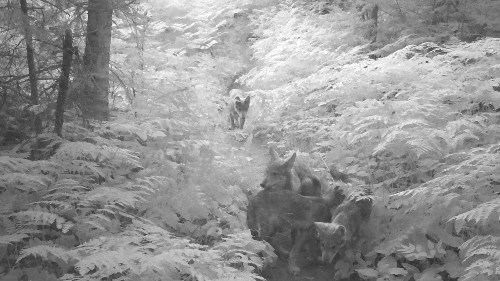Last updated: April 27, 2022
Article
Renewal and Rebirth: Isle Royale's Wolves

NPS Photo/SUNY Photo
Three years ago, the introduction of new wolves began. Now with 19 wolves translocated, the formation of at least two packs, and litters of island pups practicing their howling once again; we have witnessed the rebirth of a population.
Though challenged by the pandemic, the NPS and its collaborators have been keeping tabs on the wolves by using GPS collars and remote cameras, collecting scat for generic analysis, and through visitor observations.
For 2021, preliminary data from remote cameras indicated at least 17 wolves in two packs, each with an unknown number of pups, plus a number of individual wolves. Genetic evidence and additional analysis of remote camera data will further hone in on 2021's numbers.
As predators, these new wolves seem similar to their predecessors. They have no problems killing moose and seem to be especially adept at killing beaver in the summer.
But in other ways the new wolves are different. Some have been proficient swimmers, frequenting offshore islands. Could this be to avoid interactions with other wolves? To seek prey? Is it a behavior they acquired prior to translocation? The answer is unclear, but the frequency of offshore island use has been surprising.
The new wolves are bigger. A Great Lakes wolf's average weight is 50-70 and 60-80 pounds for an adult female and male, respectively. In spring 2021, an adult male weighing 94 pounds, and his offspring, two males and one female, weighing 85, 74, and 64 pounds were captured. Definitely above average!
A concerning change is the wolves' reluctance to yield the trail to hikers. In the past, wolves would slip on and off the trail without ever being noticed. Sightings were rare. The past two summers have seen increasing numbers of visitor wolf observations. We need to respect each other's space and give each other plenty of it.
As the park and its collaborators continue to monitor this fledgling population, I'm sure, like their predecessors, these new wolves will have many things to teach us about adapting to change.
Mark Romanski
Biologist/Natural Resource Program Manager, Isle Royale National Park
